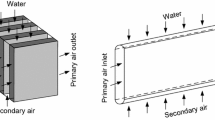Abstract
This paper numerically investigates the performance of a novel combined cross-regenerative cross flow (C-RC) thermoelectric assisted indirect evaporative cooling (TIEC) system. This C-RC TIEC system combines the indirect evaporative cooling and thermoelectric cooling technologies. A heat and mass transfer model is developed to perform the performance analysis and optimization of this novel system. Performance comparison between the novel C-RC TIEC system and a regenerative cross flow TIEC system is conducted under various operating conditions. It is found that the novel system provides better performance with higher coefficient of performance (COP) and higher dew point effectiveness than the regenerative cross flow TIEC system, especially under smaller working current and smaller number of thermoelectric cooling modules. The performance optimization of the novel system is also made by investigating the influences of primary air parameters, three different mass flow rate ratios, as well as the length ratio of the left wet channel to the whole wet channel. The results show that there exist optimal mass flow rate ratios and wet channel length ratio resulting in the maximum COP.
Similar content being viewed by others
References
Shahzad M.K., Chaudhary G.Q., Ali M., Sheikh N.A., Khalil M.S., Rashid T.U., Experimental evaluation of a solid desiccant system integrated with cross flow Maisotsenko cycle evaporative cooler. Applied Thermal Engineering, 2018, 128: 1476–1487.
Suryan A., Lee J.K., Kim D.S., Kim H.D., Numerical Simulation of Duct Flow with Fog Droplet. Journal of Thermal Science, 2010, 19(6): 533–539.
Senthilkumar K., Srinivasan P.S.S., Application of Taguchi Method for the Optimization of System Parameters of Centrifugal Evaporative Air Cooler. Journal of Thermal Science, 2010, 19(5): 473–179.
Kim H., Ham S., Yooh D., Jeong J., Cooling performance measurement of two cross-flow indirect evaporative coolers in general and regenerative operation modes. Applied Energy, 2017, 195: 268–277.
Riangvilaikul B., Kumar S., An experimental study of a novel dew point evaporative cooling system. Energy and Buildings, 2010, 42: 637–644.
Jafarian H., Sayyaadi H., Torabi F., A numerical model for a dew-point counter-flow indirect evaporative cooler using a modified boundary condition and considering effects of entrance regions. International Journal of Refrigeration, 2017, 84: 36–51.
Duan Z., Zhan C., Zhao X., et al., Experimental study of a counter-flow regenerative evaporative cooler. Building and Environment, 2016, 104: 47–58.
Mahmood M.H., Sultan M., Miyazaki T., et al., Overview of the Maisotsenko cycle e a way towards dew point evaporative cooling. Renewable and Sustainable Energy Reviews, 2016, 66(C): 537–55.
Anisimov S., Pandelidis D., Theoretical study of the basic cycles for indirect evaporative air cooling. International Journal of Heat and Mass Transfer, 2015, 84: 974–989.
Anisimov S., Pandelidis D., Jedlikowski A., Polushkin V., Performance investigation of a M (Maisotsenko)-cycle cross-flow heat exchanger used for indirect evaporative cooling. Energy, 2014, 76: 593–606.
Cui X., Chua K., Yang W., Numerical simulation of a novel energy-efficient dew-point evaporative air cooler. Applied Energy, 2014, 136: 979–88.
Fakhrabadi F., Kowsary F., Optimal design of a regenerative heat and mass exchanger for indirect evaporative cooling. Applied Thermal Engineering, 2016, 102: 1384–1394.
Lee J., Lee D.Y., Experimental study of a counter flow regenerative evaporative cooler with finned channels. International Journal of Heat and Mass Transfer, 2013, 65: 173–179.
Pandelidis D., Anisimov S., Rajski K., et al., Performance comparison of the advanced indirect evaporative air coolers. Energy, 2017, 135: 138–152.
Moshari S., Heidarinejad G., Fathipour A., Numerical investigation of wet-bulb effectiveness and water consumption in one-and two-stage indirect evaporative coolers. Energy Conversion and Management, 2016, 108: 309–321.
Xu P., Ma X., Zhao X., Fancey K., Experimental investigation of a super performance dew point air cooler. Applied Energy, 2017, 203: 761–777.
Rafique M.M., Rehman S., Alhems L.M., Shakir M.A., A liquid desiccant enhanced two stage evaporative cooling system development and performance evaluation of a test rig. Energies, 2018, 11(1): 72.
Fakhrabadi F., Kowsary F., Optimal design of a hybrid liquid desiccant-regenerative evaporative air conditioner. Energy and Buildings, 2016, 133: 141–154.
Comino F., Ruiz de Adana M., Peci F., Energy saving potential of a hybrid HVAC system with a desiccant wheel activated at low temperatures and an indirect evaporative cooler in handling air in buildings with high latent loads. Applied Thermal Engineering, 2018, 131: 412–427.
Liu Z.B., Zhang L., Gong G.C., Experimental evaluation of a solar thermoelectric cooled ceiling combined with displacement ventilation system. Energy Conversion and Management, 2014, 87: 559–565.
Irshad K., Habib K., Thirumalaiswamy N., et al., Performance analysis of a thermoelectric air duct system for energy-efficient buildings. Energy, 2015, 91(3): 1009–1017.
Zhou Y., Zhang T., Wang F., Yu Y., Performance analysis of a novel thermoelectric assisted indirect evaporative cooling system. Energy, 2018, 162: 299–308.
Zhou Y., Yu J., Design optimization of thermoelectric cooling systems for applications in eletronic devices. International Journal of Refrigeration, 2012, 35(4): 1139–1144.
Liu Z., Allen W., Modera M., Simplified thermal modeling of indirect evaporative heat exchangers. HVAC&R Research, 2013, 19(3): 257–67.
Lim H., Cheon S.Y., Jeong J.W., Empirical analysis for the heat exchange effectiveness of a thermoelectric liquid cooling and heating unit. Energies, 2018, 11(3): 580.
Anisimov S., Pandelidis D., Danielewicz J., Numerical study and optimization of the combined indirect evaporative air cooler for air-conditioning systems. Energy, 2015, 80(2): 452–464.
Lemmon E.W., McLinden M.O., Huber M.L.,Reference fluid thermodynamic and transport properties (REFPROP). NIST Standard Reference Database 23, Version 9.0, 2010.
Acknowledgement
The work is financially supported by the National Natural Science Foundation of China (No. 51706099). The authors would like to express sincere thanks for the sponsorship.
Author information
Authors and Affiliations
Corresponding author
Rights and permissions
About this article
Cite this article
Zhou, Y., Zhang, T., Wang, F. et al. Numerical Study and Optimization of a Combined Thermoelectric Assisted Indirect Evaporative Cooling System. J. Therm. Sci. 29, 1345–1354 (2020). https://doi.org/10.1007/s11630-020-1362-7
Received:
Published:
Issue Date:
DOI: https://doi.org/10.1007/s11630-020-1362-7




